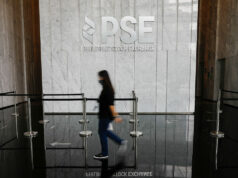By Joseph L. Garcia, Reporter

THE JAPANESE have a habit of taking something foreign and improving upon it, resulting in a product sometimes far superior than the original: think Japanese jeans, whiskey, or jazz. These Japanese sensibilities meet with Australian techniques in Japan-based steakhouse Ruby Jack’s, which has a branch in City of Dreams.
A tasting last week in the steakhouse’s Philippine arm was graced by the presence of Matthew Crabbe, the CEO and chef director of ECN, the holding company behind Ruby Jack’s, which also has under its umbrella Two Rooms and R2 Superclub in Japan.
Mr. Crabbe takes the high Japanese standards and applies these to his food. “As a foreigner living and working in Japan as a chef, there’s no way I would even attempt to do Japanese food,” he said. He has been in Japan since 2001, brought from across the world to become the head chef of New York Grill in Tokyo, which will be preserved for posterity as a location in the film Lost in Translation.
Now let’s see to those high standards. For last week’s tasting, the crown jewel was, of course, the steak. The dry-aged beef had been veiled in cheesecloth soaked in Jack Daniel’s for 30 days, and the result was an aggressive steak, blushing furiously red, yielding a flavor that was both gamey and intense. As for the texture though, it was a delight to feel it slicing like butter under the knife, and serious lovers of beef would surely kiss someone on the mouth for thinking up this treat — who knew whisky could bring out the flavors of beef so well?
Other options included lamb chops and slices of pork, both of which had a taste that honored the animal, and as for you, diner, would be a chew that you would think of and crave for days.
When it came to the dessert options, this reporter was brought back to life with a Chocolate Rocher cake, which tried to replicate the experience of biting into the Ferrero-created confection in pastry form. A close second would be the double-baked and smoked cheesecake, which had several layers of flavor and a weight that should see you through the rest of the day.
The ingredients are all mostly from Japan, or locally sourced, and — surprise! — not all of the beef is sourced from Japan, the land of prized Wagyu.
According to Mr. Crabbe, Wagyu (literally meaning “Japanese Cow”) is graded A1 to A5, with A5 being the highest. Mr. Crabbe uses beef graded between A3 to A4, because A5-graded beef would be too fatty and well-marbled. “I don’t like that much fat content in the beef because you can’t eat it that much… it’s not good for you, basically, at the end of the day,” he said.
For everything else, he uses beef from Australia, which is more lean, but he would sometimes also source beef from the US or Argentina.
The discerning palates of the Japanese often lead to high expectations. Mr. Crabbe must be doing something right then, if he could expand an Australian steakhouse from Japan to the Philippines. “As long as you do something very well, they will appreciate it.”



